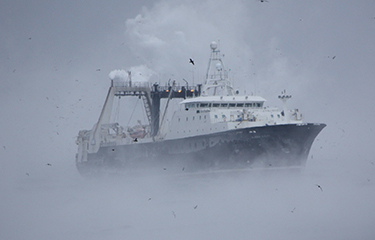Alaska pollock quota to remain flat in 2024, despite industry push for higher catch

The North Pacific Fishery Management Council, which oversees the quota of the Alaskan pollock industry, decided to maintain the same quota for the species in 2024 at its recent meeting on 9 December – despite industry calls for a higher catch.
The council’s latest meeting decided that the total allowable catch (TAC) of pollock for the Eastern Bering Sea would be 1.3 million metric tons (MT), the same quota that it had last year. The flat quota is in spite of increases in biomass, which has increased the allowable biological catch (ABC) to 2.31 million MT – up from 1.9 million MT last year.
The Eastern Bering Sea pollock stock assessment, overviewed during the meeting by Alaska Fishery Science Center Senior Scientist Jim Ianelli, highlights that current statistical modeling indicates maintaining the TAC of 1.3 million MT adds more certainty to future catch volumes, whereas increasing the fishing pressure significantly could lead to significant drop-offs in the near future.
“If you went with a Tier 3 maximum permissible, the catch would jump to something like 2.3 million MT in that year, but you would have pretty quick declines in spawning biomass,” Ianelli said. “As a contrast, if you instead say we just fish at the average fishing mortality rate that we’ve been pursuing, you’d still get a fairly high level of catch … but you’d get relatively low occurrences of where the spawning biomass would drop.”
The stock assessment also shows that there was a huge recruitment event in 2018 into 2019, and the 2022 catch indicates that fact as the overwhelming majority of pollock caught was four years old. Then, in 2023, the majority was five years old.
At-Sea Processors Association Executive Director Stephanie Madsen, addressing the council during its meetings, said her group has invested heavily in understanding the science and stock – and that its board supports a higher TAC given the large 2018 year class and the status of the stock. The APA put forward a proposal for a 1.32 million MT quota – which the council ultimately rejected.
“Our science supports that, and really 1.32 was a compromise in our group, and it was a unanimous view,” she said.
Madsen said the significantly higher ABC seems to say the quota could be higher without any negative consequences to the overall pollock biomass.
“That’s a 2 percent increase in the ABC, and some are suggesting that there be no increase in total allowable catch,” she said.
The 2018-2019 year class, which made up a significant portion of the fleets catch in 2022 and 2023, is also a reason to up the TAC.
“The 2018 year class is probably going to prove up to be one of the largest year-classes in the time series,” Madsen said. “They are aging out of the system. We can’t bank them like some fish species. They will age out of the system, and they will be not available to the fishery.”
The poor fish condition, she said, is a concern of the entire fishery – but leaving fish in the water “is not going to make them fatter.”
“There’s enough difference between the ABC and the TAC for the ecosystem considerations, there’s a lot of fish out there for the birds and the fur seals and the other species that need pollock, so we’re not in a conservation concern for pollock,” she said. “If there is not an increase in pollock in this scenario, in this environment, when can the pollock industry ever expect to see any kind of an increase?”
Photo courtesy of Glacier Fish






Share